Talent Trends Report | Candidate Sourcing
25 minute read
Topics
Table Of Contents
The data pulled in this report comes from over 500K email sequences sent through Ashby between January 2022 and January 2024. Subscribe to our Talent Trends newsletter to receive a bite-sized insight in your inbox every week.
In speaking with top talent teams, candidate sourcing continues to be an area of emphasis. Sourcing can often provide recruiting teams with a greater sense of control over their talent pipeline — especially in a world where inbound applications can fluctuate. Talent teams can set more predictable targets around outbound outreach and the movement of those ideal candidates through the rest of the recruiting funnel.
To better understand the sourcing process, we dug into half a million email sequences sent through Ashby to accomplish a few goals:
- Benchmark email open, reply, and interest rates
- Uncover trends in sourcing campaigns
- Understand how AI can streamline efficiency and improve response rates
We’ll couple our findings with some qualitative insight from top recruiters and sourcers managing high volumes of outreach activity in their organizations.
Sourcing Outreach Benchmarks
We’ll start by benchmarking the foundational metrics associated with sourcing. To fully understand the data, let’s align on the definitions behind the analysis. In our context:
- Sourcing campaign = set of one or more emails sent to a candidate
- Email open = at least one email is opened across the sourcing campaign
- Email reply = at least one email associated with the sourcing campaign is responded to
- Interest rate = one of the responses across the campaign is classified as showing interest in the job opportunity
Overall, our report looks at sourcing campaigns as a whole over individual emails.
Average Sourcing Open Rates
Across our data, we observed a fairly consistent open rate at an average of 86% from January 2022 through January 2024. This average is consistent even when splitting the sourcing campaign data by business and technical roles. [Tweet This]
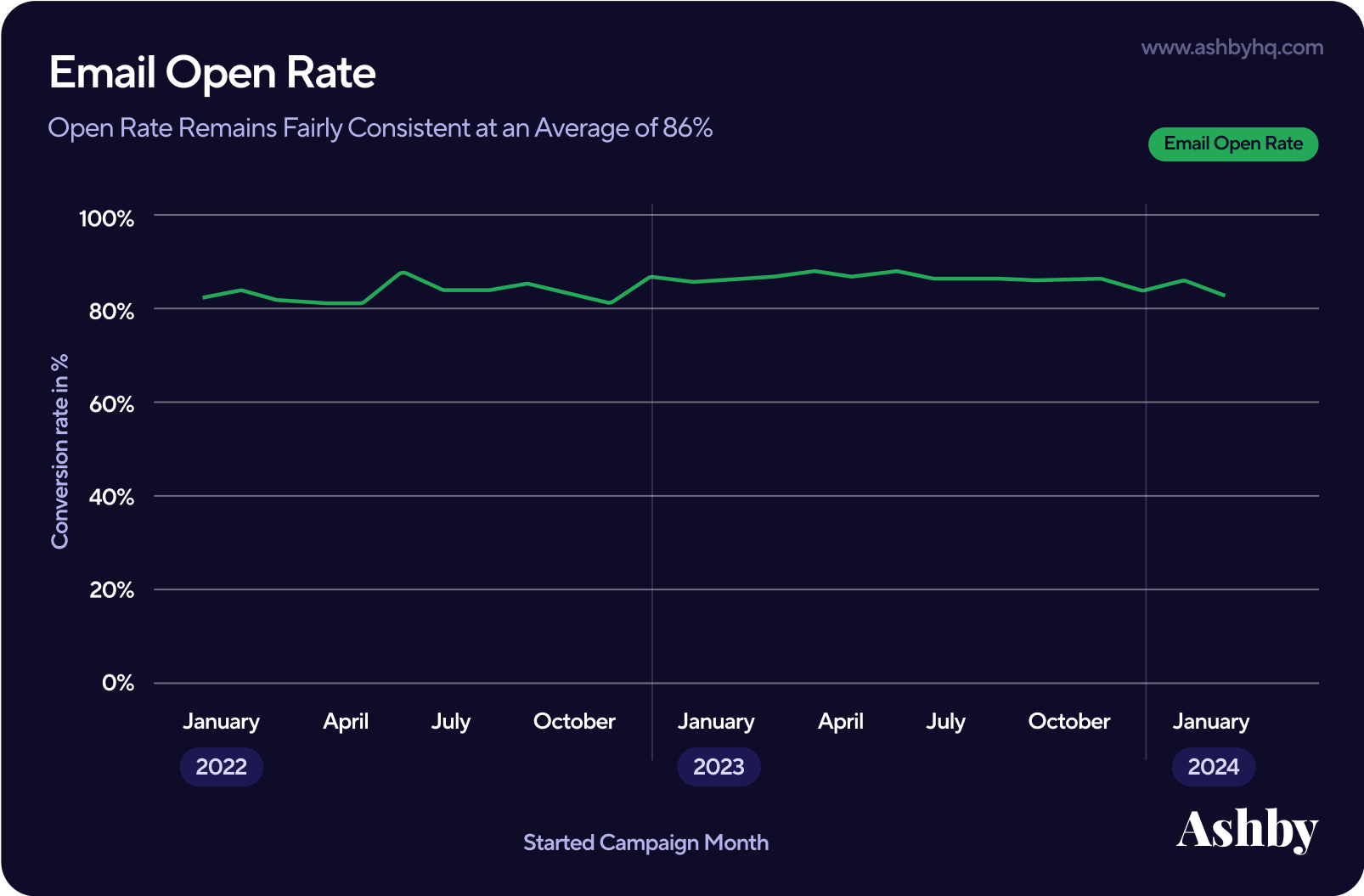
Looking at open rate across the time series shows that even amidst tumultuous times, the consistency with which potential talent opens sourcing emails remains stable.
Average Reply Rates
There are two ways to look at reply rates:
- Campaign Reply Rate: the number of candidates who have replied to any of the emails in your sourcing sequence
- Open to Reply Rate: replies from those who opened any of them emails in your sourcing sequence
Throughout this report, we focus on Campaign Reply Rate. From our conversations with recruiters, Open to Reply Rate can be a helpful second layer of exploration when needed. For example, if your emails are getting a lower than expected response rate, that would merit exploring the Open to Reply Rate. GDPR considerations also often increase reliability on Campaign Reply Rate in a world where email open tracking is not an option.
Across the half million sequences we analyzed for Campaign Reply Rate, we see a 19.6% average response rate from January 2022 to January 2024. [Tweet This]
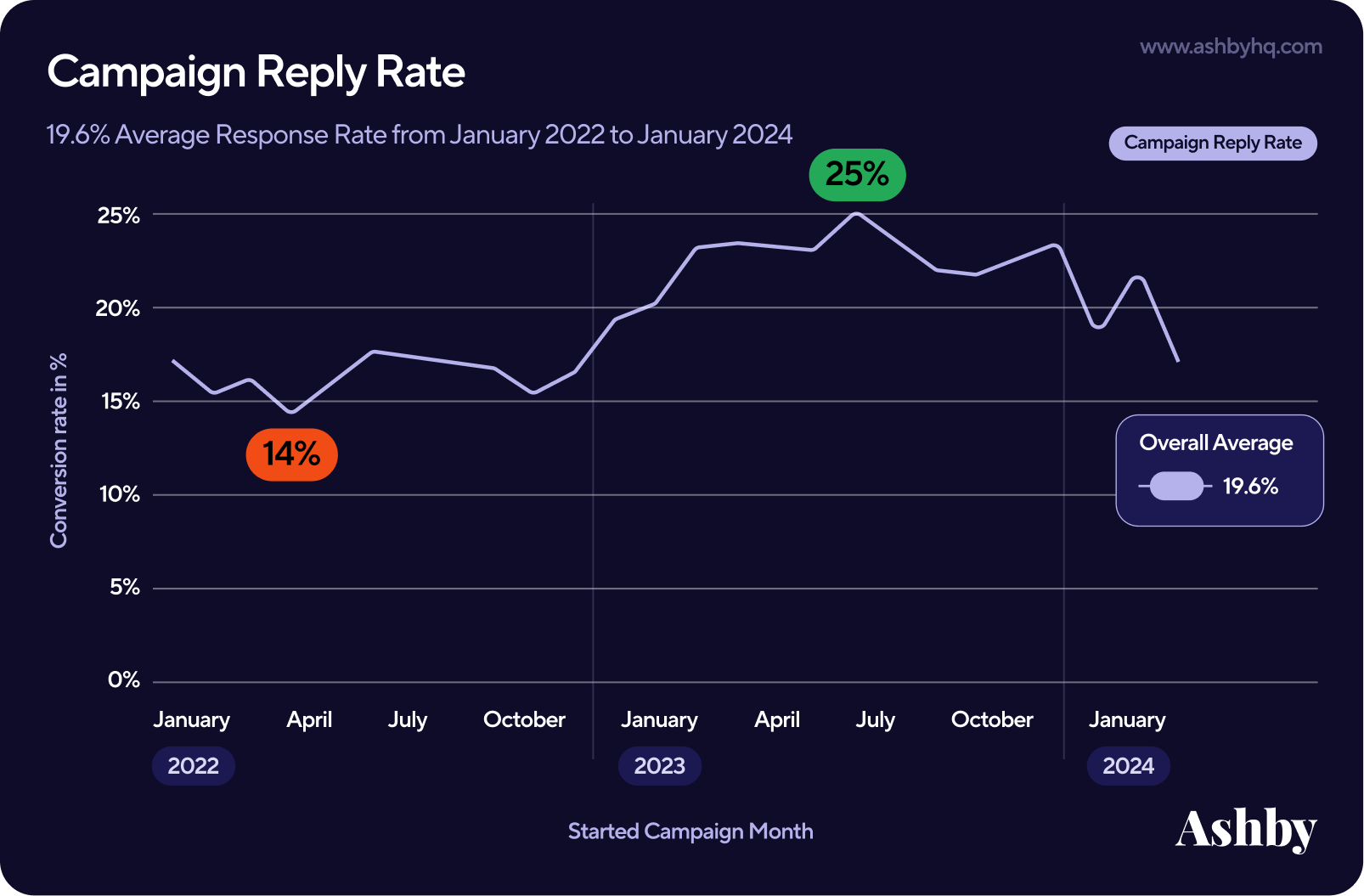
Potentially more interesting is zooming into the start of 2023 when both response rates jumped and then remained 30-40% higher in 2023 than all of 2022.
Looking at this data by function reveals minor differences:
- Business Roles: 18.7% reply rate per outreach campaign
- Technical Roles: 19.4% reply rate per outreach campaign
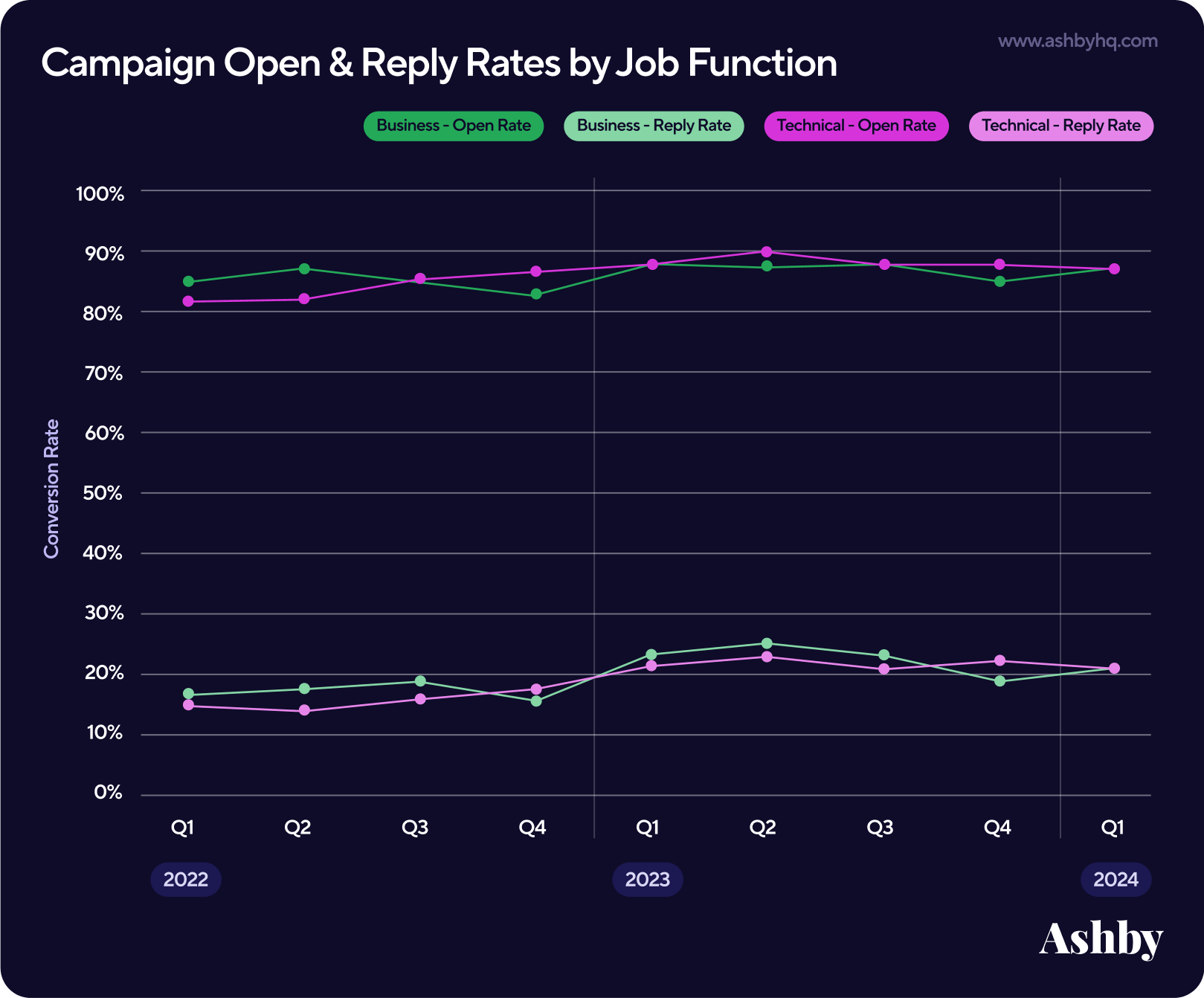
The beginning of 2023 is also when we observed a rise in applications per open role that has only continued to grow in 2024. Possibilities here include increase in talent pool from layoffs, higher likelihood to respond to recruiters given anxiety of potential layoff, or simply more companies hiring in 2023. In any scenario, there may be some relation between job availability and increased willingness to respond to a sourcing sequence.
Reply & Interest Rate by Campaign Setup
Across our data set, the majority of sourcing campaigns employed up to four emails in a sequence. As seen below, most sequences are configured to send three emails, and the overall reply rate takes a huge step up by including at least one additional email. However, including more than three emails does not significantly improve overall reply rates, which plateau around 23%.
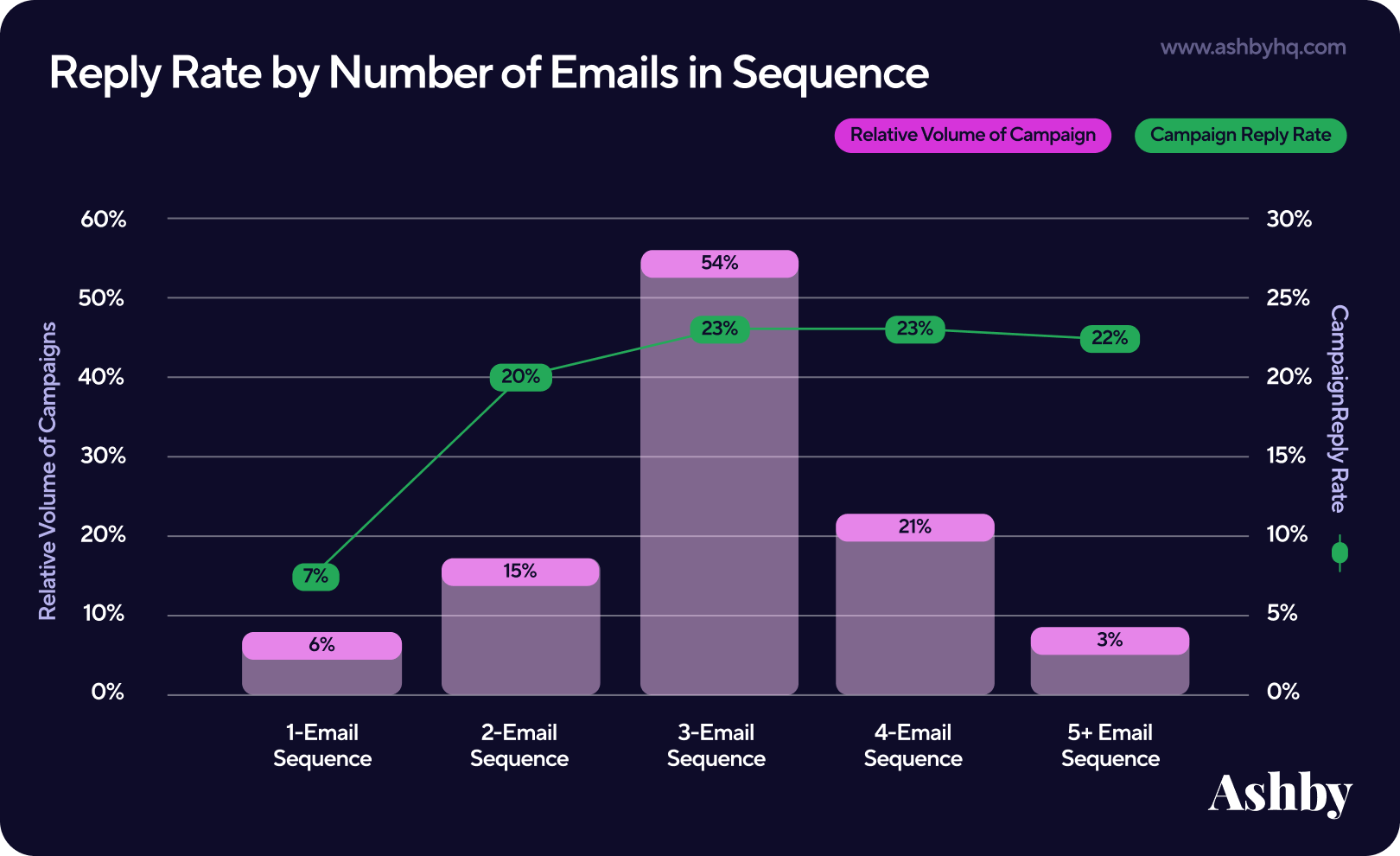
We can analyze the reply rates per at first email, at second email, and at third email in more detail to see what differences there might be. Taking campaigns configured to send three emails as an example, we see that almost half of all replies are a response to the first email.
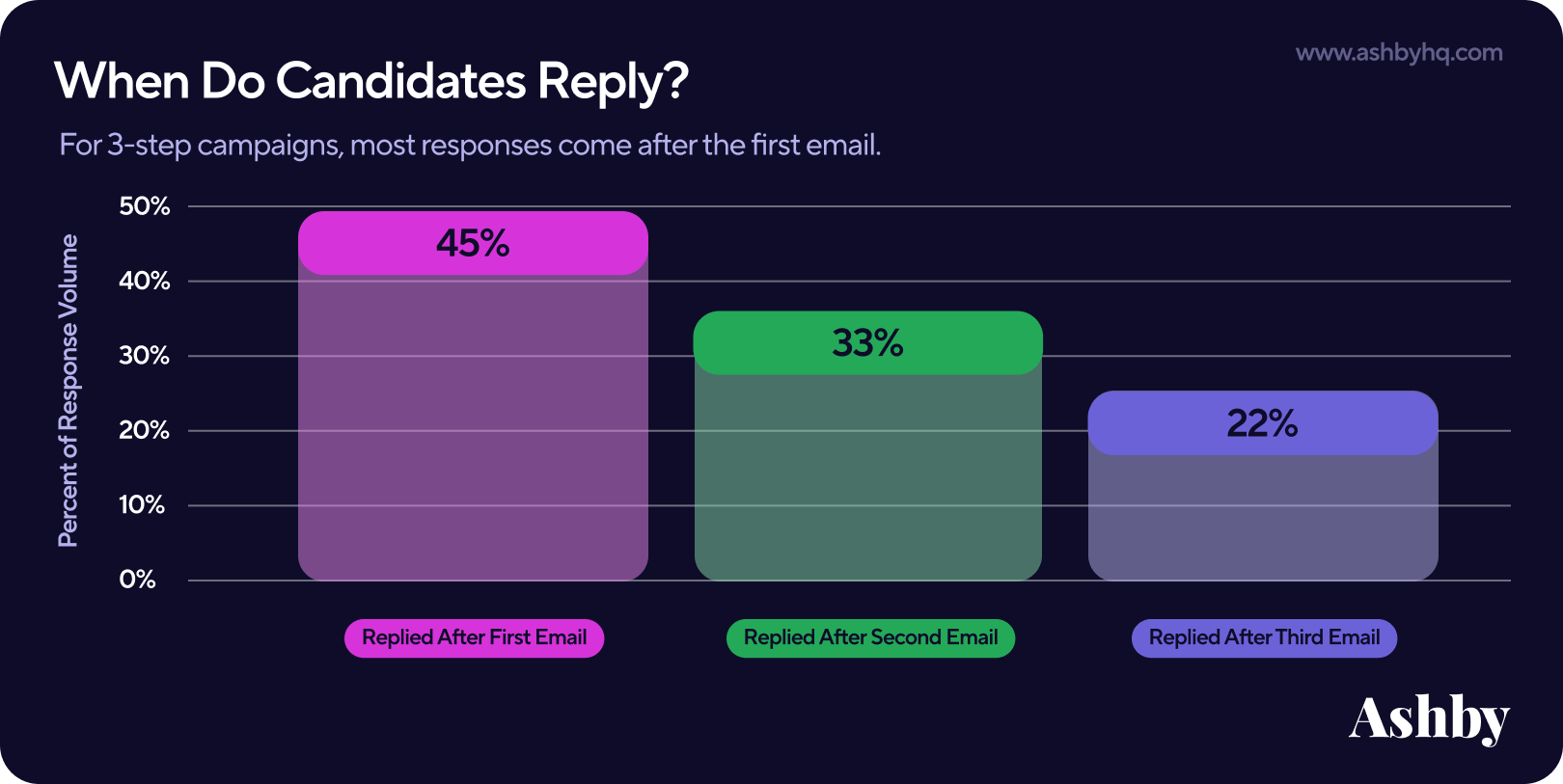
Looking at this data for your own strategy will prove most valuable. In the case of Ramp, their talent team sees more responses come after the first email.
“When we send out our sequences, most sourcers here at Ramp have three or four stages with data showing we get the most response on the second or third outreach versus that first one.”
— Sonya Yeonas, Technical Recruiting Manager at Ramp
We wrapped up our outreach analysis by going one layer deeper and breaking down the reply rate by the candidate’s expressed interest. As Ashby allows sourcers to classify responses manually or automatically with AI classification, we can look at which emails in your campaign have the most leverage.
For Ashby customers, here's how our AI classification looks:
Looking at this data, we observe an average 37.7% interest rate across sourcing campaigns with a significant peak of interest for those who respond after receiving the first email. [Tweet This]
You can imagine scenarios where a company with a strong employer brand or company culture can lead to a somewhat immediate response.
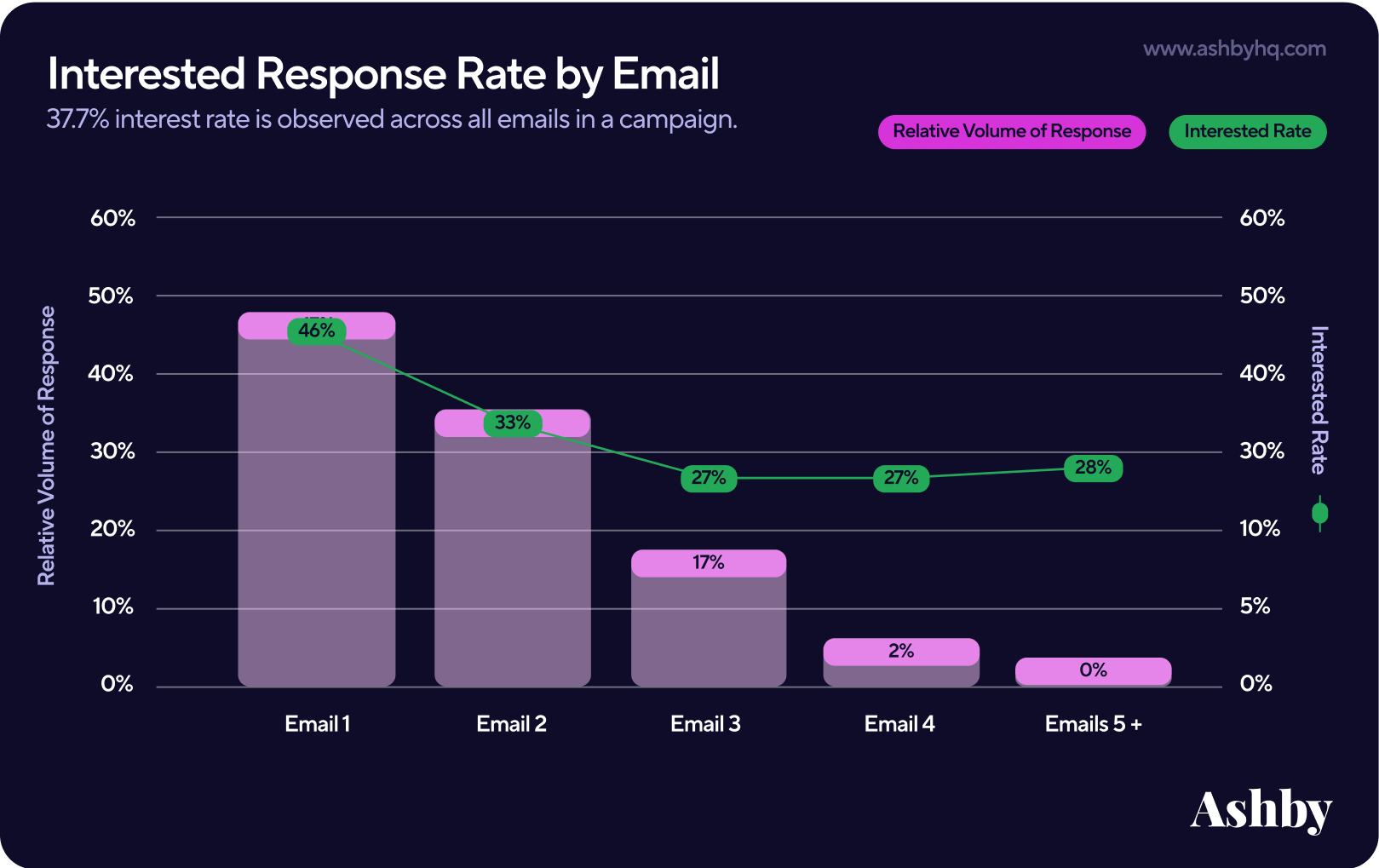
We also noticed that most recruiters today are setting up campaigns with four days between each email. The decision here likely depends on what works well for your open positions or time-to-hire goals associated with your candidate sourcing process.
With all the above, we can now see how these benchmarks flow through a sourcing funnel.
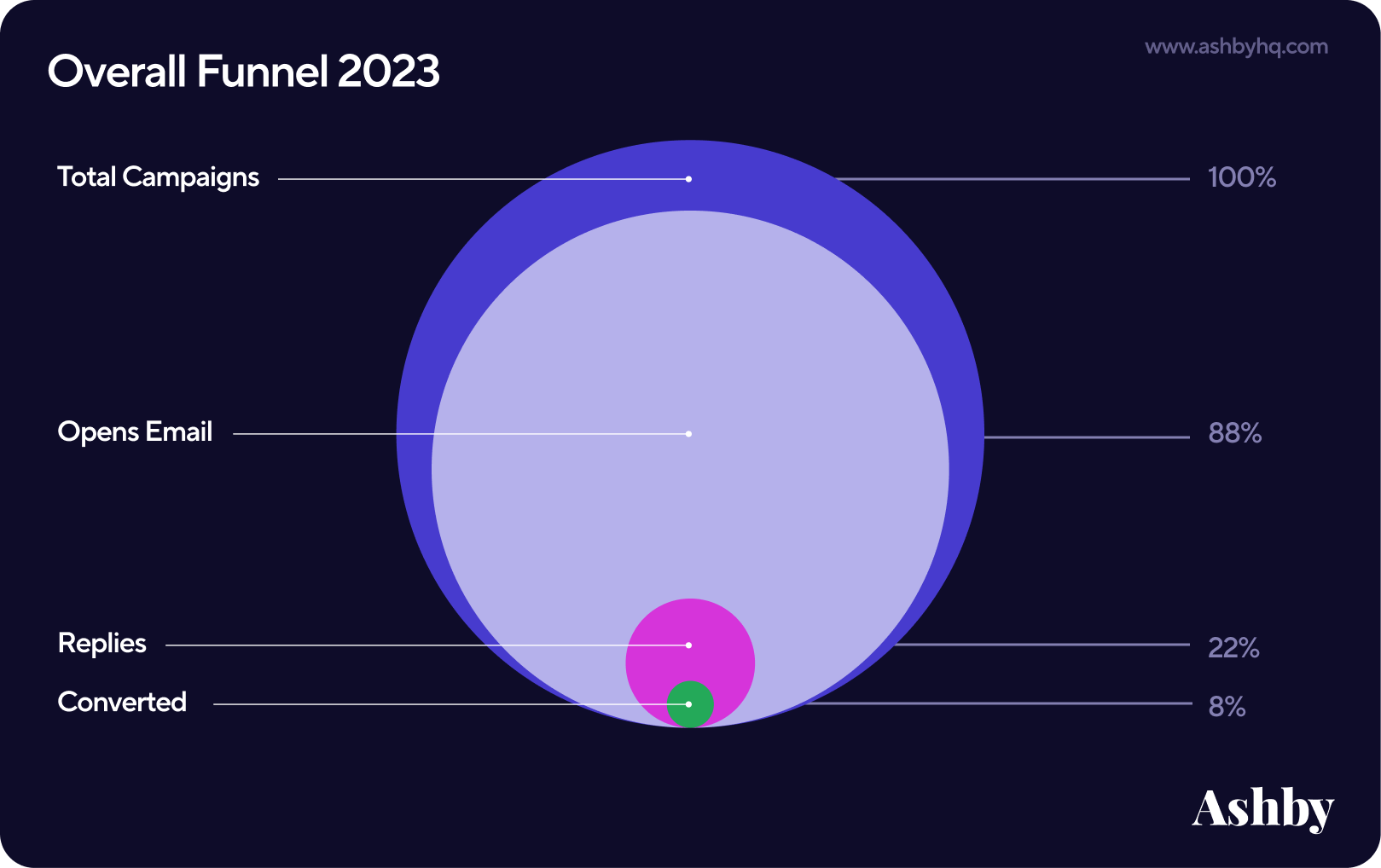
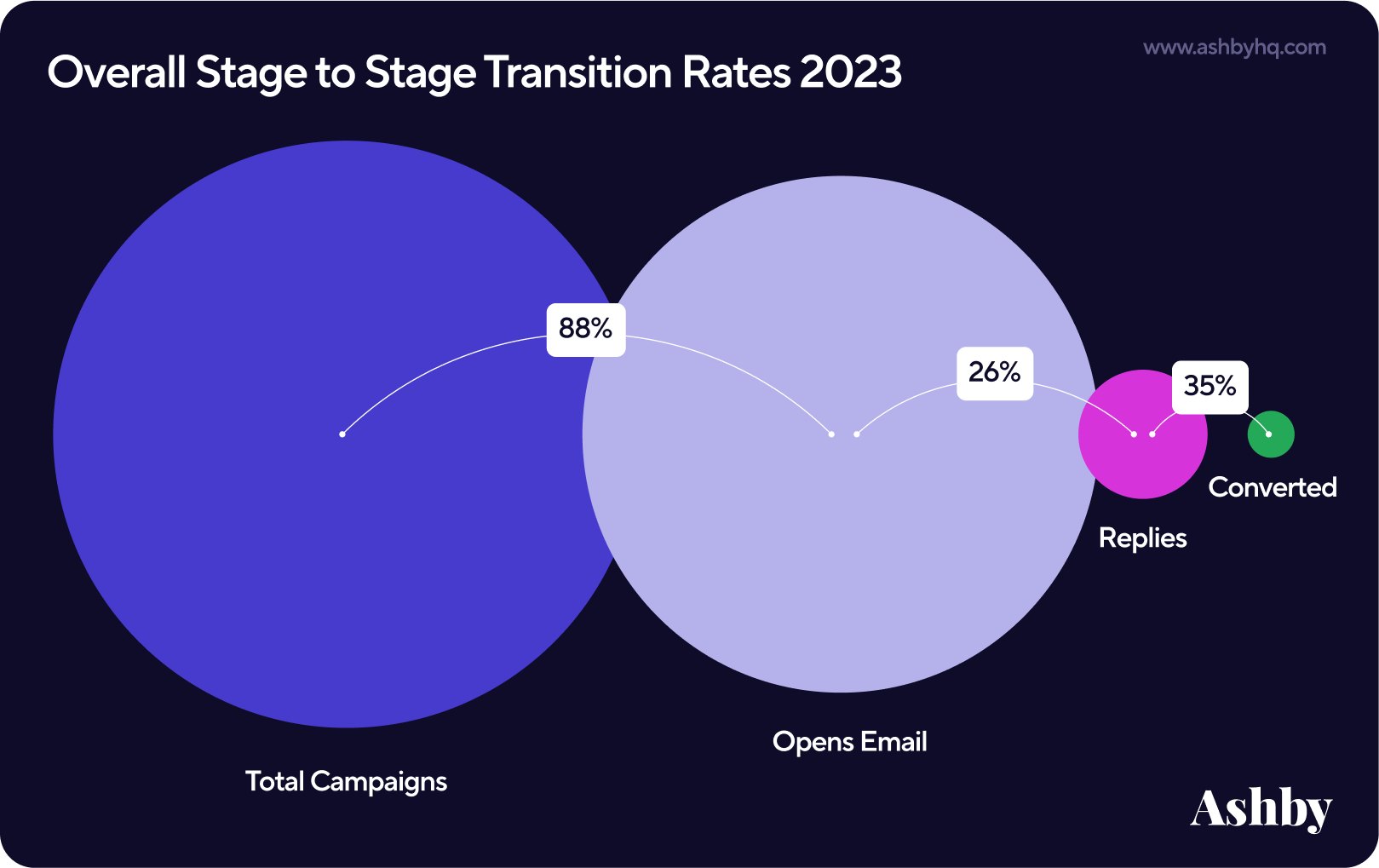
Talent Teams with Above Average Outreach Performance
To take a peek under the hood of the data findings throughout this report, we spoke with Ashby customers who rank as the top three for sourcing performance. Each of these recruiting teams have well above average email open and reply rates.
First, let’s congratulate Blacksmith Agency, Ramp, and Liveflow for their sourcing process and success!

Sprinkled throughout this report are insights directly from these talent acquisition teams:
- Autumn Gomez, Team Lead Corporate Recruiter at Blacksmith Agency
- Juan Herrera, Corporate Recruiter at Blacksmith Agency
- Sonya Yeonas, Technical Recruiting Manager at Ramp
- Kiera Cox, Technical Recruiting at Liveflow
Outreach Rates by Job Category
Looking at open and reply data by functional department, we can see which types of qualified candidates are more likely to reply to sourcing campaigns (such as Legal and Recruiting) versus which are less likely to reply (such as Finance or Engineering).
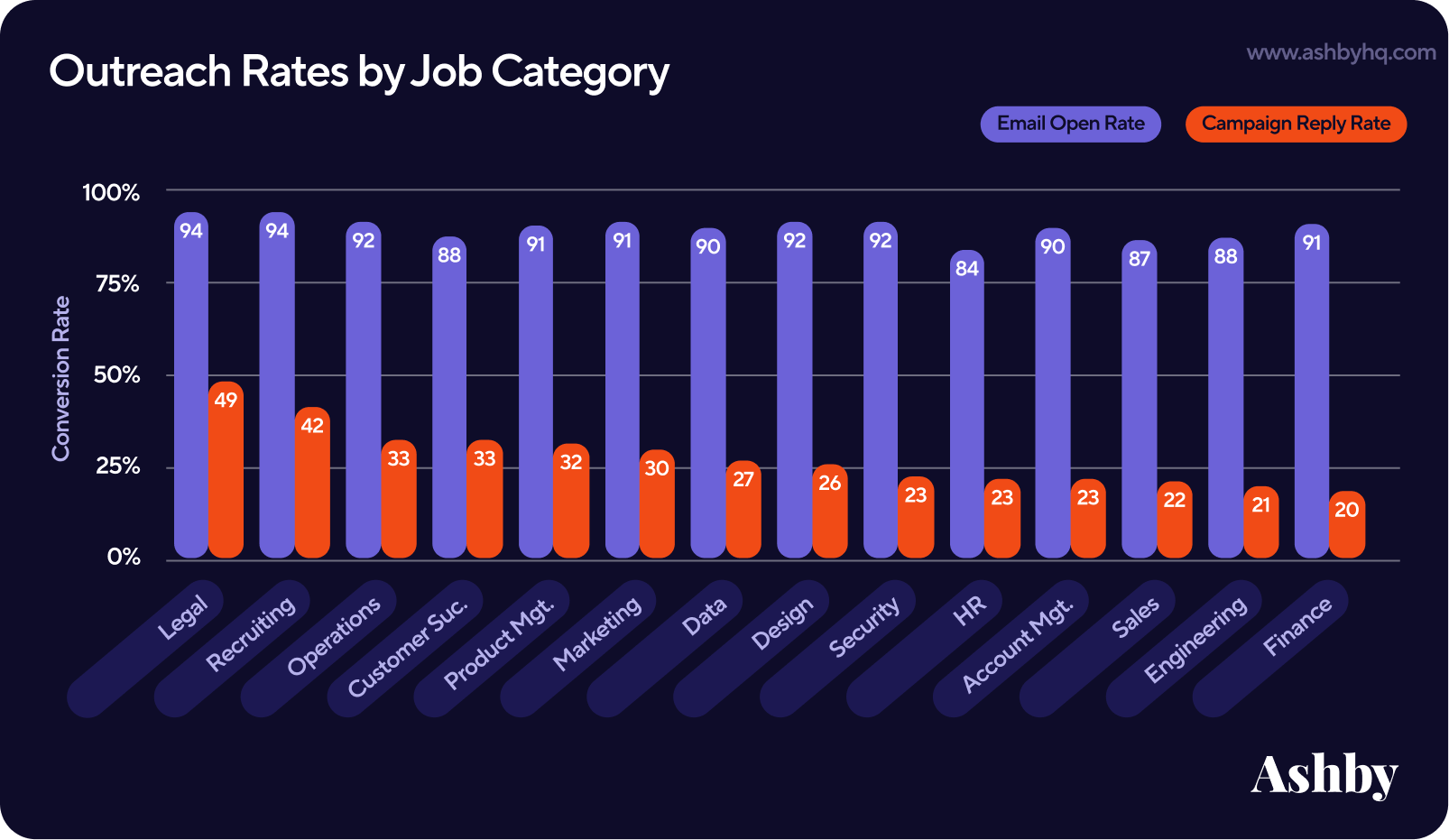
When slicing our overall dataset in different views, we quickly found that there wasn’t much variance in open or reply rates when specifying by industry, company size, or other factors that one may consider. As such, we spared the inclusion here and recommend using the aforementioned averages across the spread as benchmarks for your candidate sourcing strategies. That said, job category was the one area of interest we continued to explore, with more findings later in this report.
Outreach Rates by Day or Time
To further click into the overall campaign performance data, we began plotting the data by when a sourcing campaign was sent. We first looked by week before drilling further and further, making our way to the specific hour. The data here is reflective of Ashby’s global customer base and not localized to any specific time zone.
Looking at performance by day of week, we can see some intuitive trends for both the recruiter and candidate — for example, Saturday being the lowest performer for open rate success. Most likely, the stronger signal of campaign performance over day of week is the quality of the outreach itself.
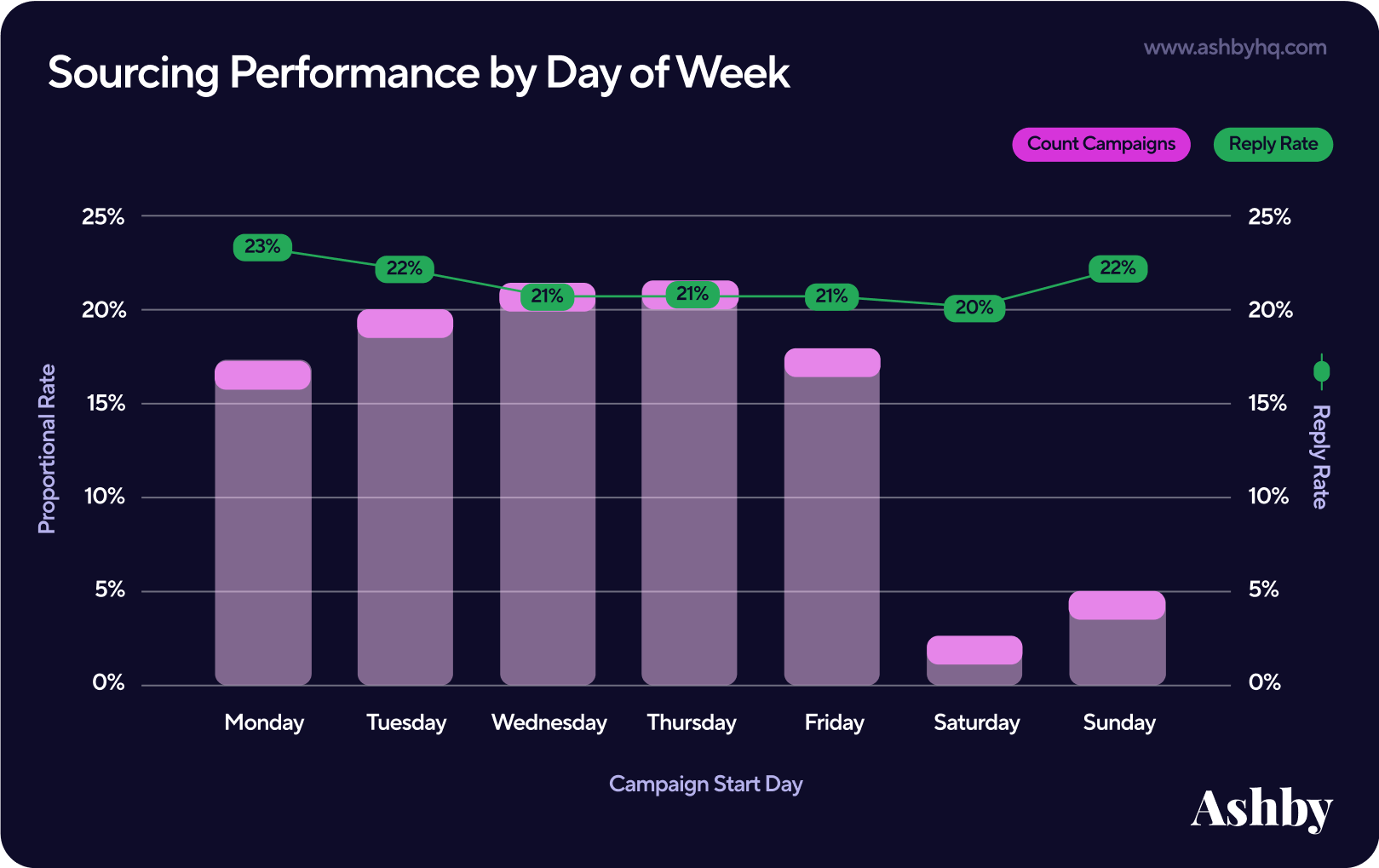
A potential next step to action this data would be to map these insights to your own candidate sourcing strategy. For example, if you’re investing more sourcing effort into personalizing campaigns, how does that affect reply rates? We’ll dig into this in our AI sourcing section at the end of this report as well.
We next grouped the data by logical buckets based on standardized working and non-working hours. Here we can see a fairly consistent reply rate across all time buckets, with a slight peak for campaigns sent between 12 PM and 6 PM local time to the creator of the campaign (most often the sourcer or recruiter).
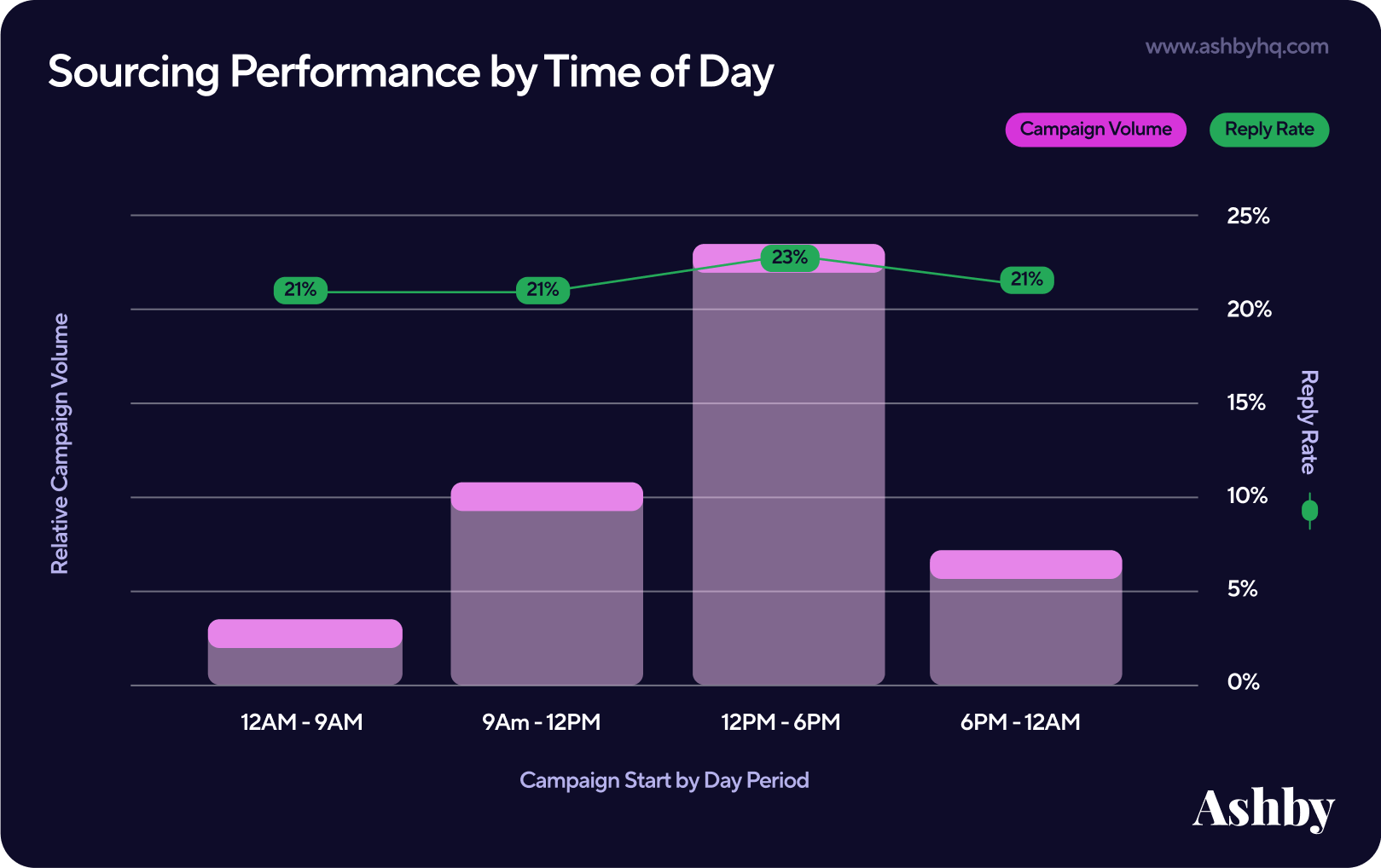
It may be worthwhile to test scheduling your sourcing campaigns between 12 to 6 PM local time to your business or candidate and see how it impacts responses! Ramp takes this approach of using data to inform their sourcing strategy.
“A lot of our sourcers look at what days to send their sequences or time of day which is helpful. We analyze sourcing activity through our Ashby dashboards with reply rates, passthrough rates for sourced candidates, sequences sent weekly, time to fill, and conversion rates overall.”
— Sonya Yeonas, Technical Recruiting Manager at Ramp
Breaking out this data by hour shows a slightly less actionable story, but interesting nonetheless. We can see an intuitive peak in sourcing activity from roughly 10 AM to 4 PM, though reply rates run a spectrum over the course of 24 hours with the most stability during the same 10 AM to 4 PM window.
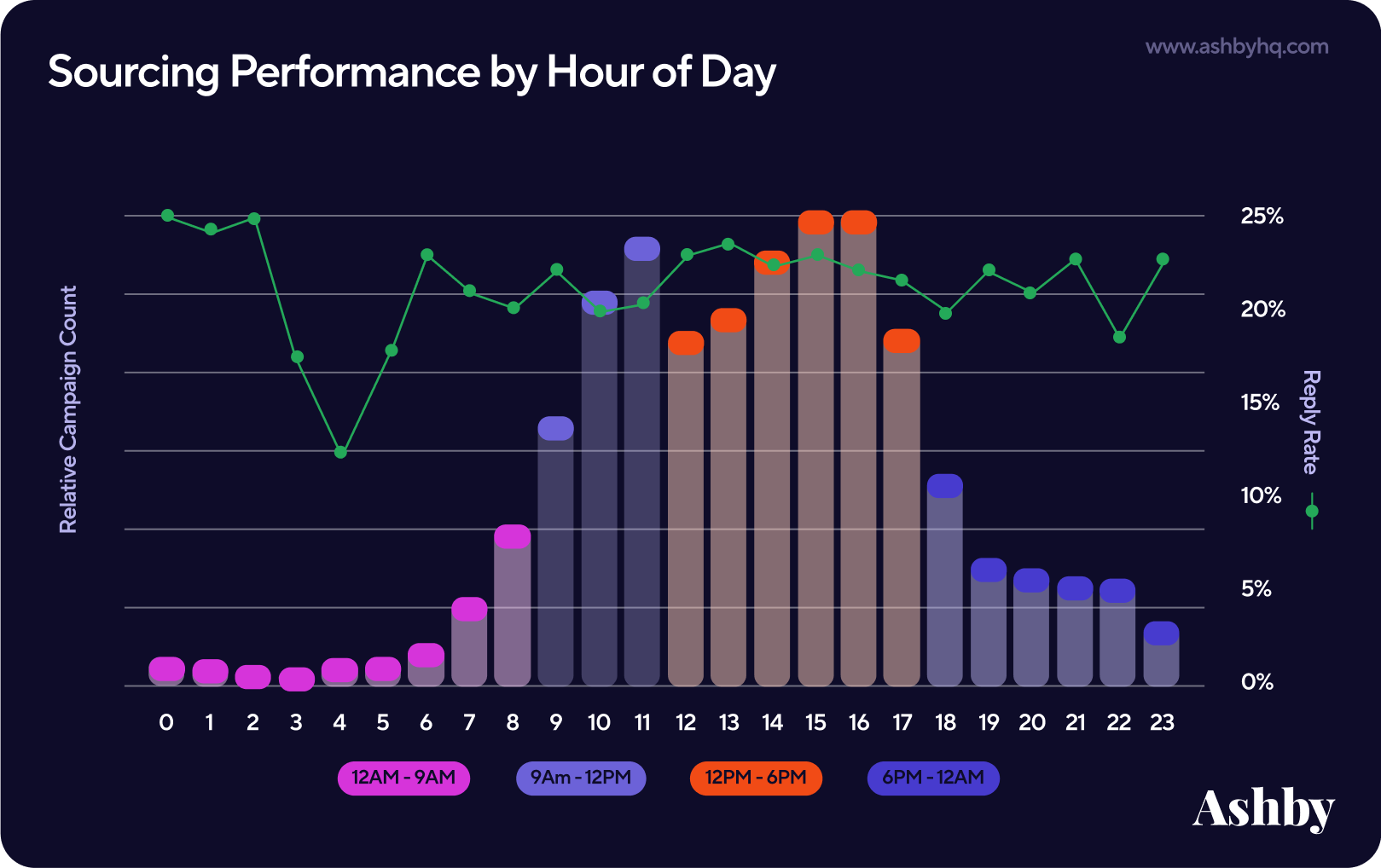
Trends in Sourcing Campaigns
Next, let’s zoom out to how sourcing activity overall is trending.
Sourcing Campaigns
While email open and reply rates didn’t see massive waves of fluctuation, recruiting team time did. The volume of outreach campaigns overall went on a downward swing in the second half of 2022 before bottoming out in the first half of 2023.
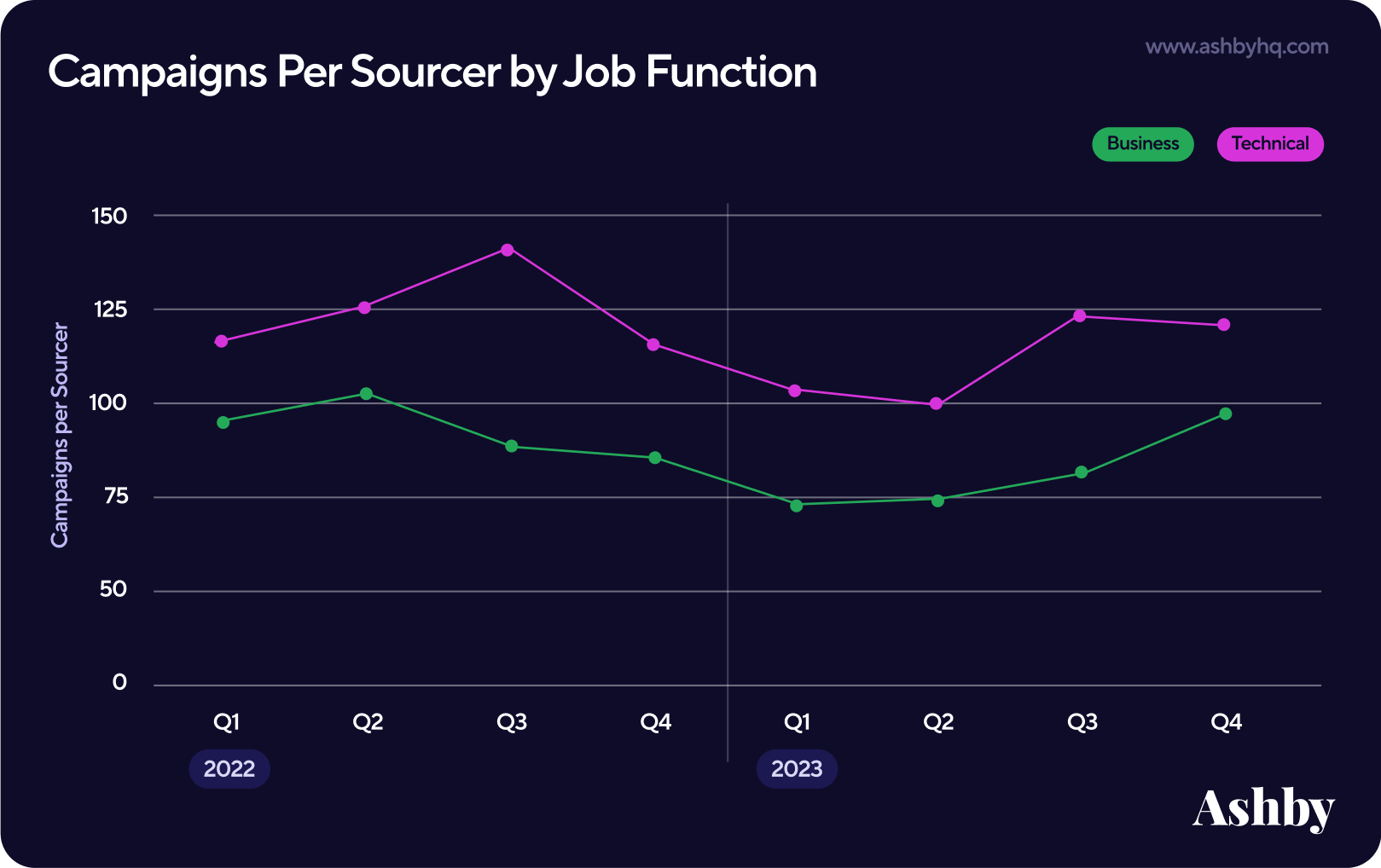
“Per sourcer” here means per individual who authors a campaign. Roles in both business and technical roles saw an uptick in sourcing campaigns in the second half of 2023, with a sharper spike observed for technical roles. While a reduction in outreach is typical during year-end holidays (as seen at the end of 2022), it’s less typical to see the rise observed at the end of 2023.
There can be a myriad of reasons driving this upswing. Potential rationale includes:
- Uptick in Job Openings: Both the September 2023 and December 2023 Jobs Reports surprised economists, with September accelerating the pace of hiring and December outpacing expectations. As more job postings opened at the end of 2023, more campaigns were likely needed to fill them.
- Team Expansion: Some talent teams began expanding their recruiting teams and thereby expanding the number of sourcing campaigns per organization. In speaking with Ramp as one sample data point, they doubled their sourcing team in 2023.
- Higher Level Hiring: Other teams we spoke with referenced a recent trend in companies looking for more senior talent as a response to layoffs. “Head of” or Director-level talent often requires more outbound outreach than inbound applicants.
Naturally, it’s possible that different teams lean more or less on sourcing pending the role. We took a brief look at the volume of campaigns against job category alongside inbound application volume in the same categories. We report on the latter in our 2023 Applications per Job Report, analyzing 13M applications to see how job seekers are applying for open roles.
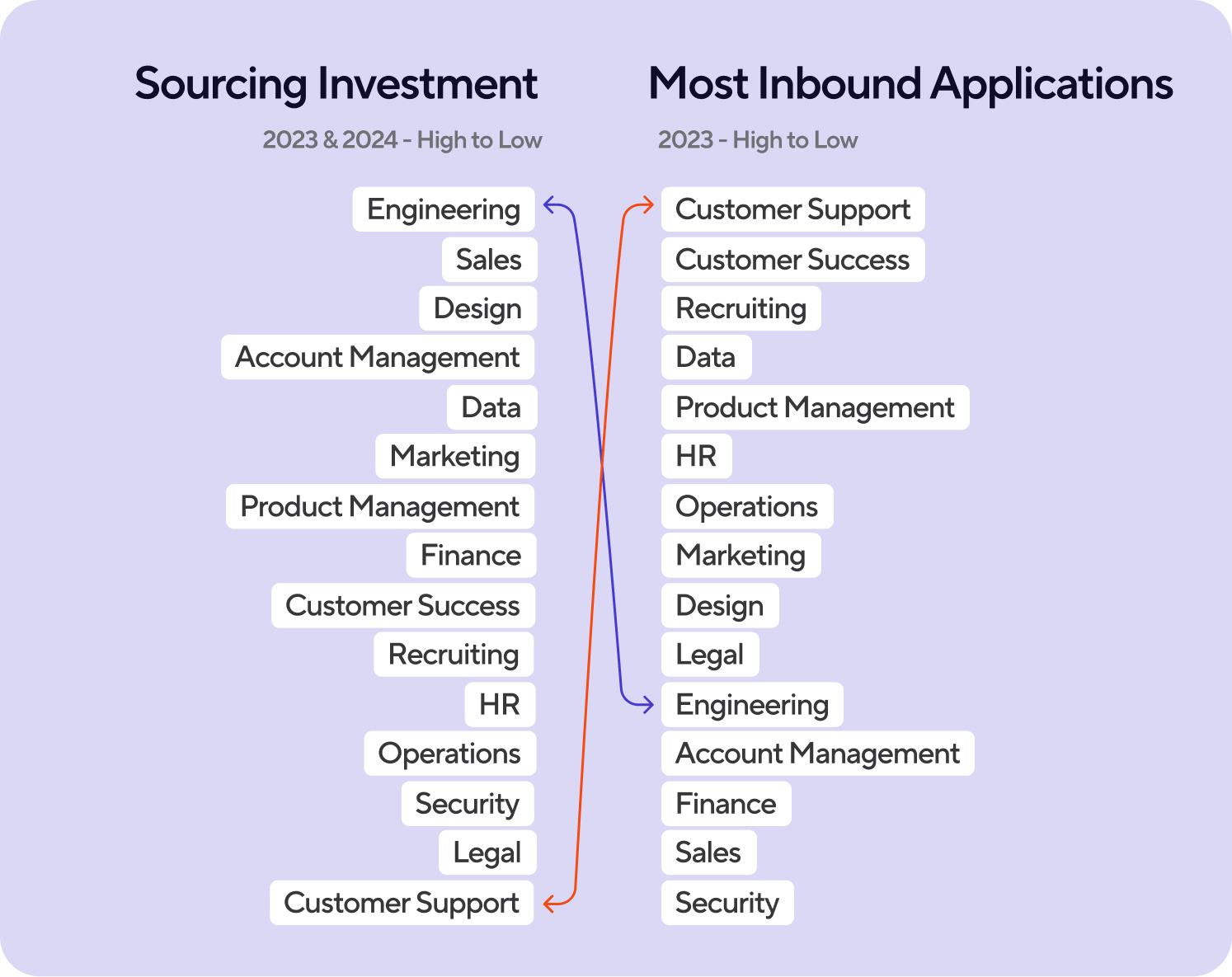
Immediately we noticed a few trends:
- Roles in Engineering have high counts of sourcing activity - this intuitively stands its ground as these are often the functions with the most evergreen hiring.
- While Customer Support has the lowest volume of sourcing campaign investment, support roles received the highest volume of inbound in 2023. This could signal that most Customer Support pipeline is more easily filled with inbound applications than outbound sourcing.
- The reverse seems to be true for Sales roles — Sales seems to be driven far more by outbound sourcing campaigns than inbound applications, seeing the second lowest volume of inbound in our 2023 data.
LinkedIn Sourcing
Another interesting sourcing trend stems from how teams review profiles on social media platforms. We found that sourcers are reviewing an extra LinkedIn profile for every four candidates added to a pool. [Tweet This]
- In 2022, recruiters reviewed 5 profiles to add 4
- In 2023, this increased to reviewing 6 profiles to add 4
Of course, sourcing efforts involve many activities in addition to sourcing new candidates from social networks like LinkedIn. This includes sourcing directly from your own CRM, how search filters are set up, other resume sources (Indeed, other job boards, meetups/job fairs, etc), and more.
Nonetheless, we found this trend interesting to explore and spoke with Ashby customers who referenced a number of elements that could be influencing their recruitment process. Here’s what we heard from them.
Liveflow: Recruiting Team Background
More recruiting teams are operating leanly. Liveflow’s lean team is led by a Technical Recruiter Kiera Cox, who often has to support in filling GTM roles. While Kiera has full confidence in the ideal technical profile for the company given her years of experience, for GTM roles she naturally has to invest more time and review more profiles to find the best talent for her job title. This is a trend we’ve heard across teams doing similar hiring with fewer people on the team.
Blacksmith: Role Seniority
As mentioned earlier, the macro hiring environment has led some teams to focus their hiring process on more senior level talent. At Blacksmith, this translates into reviewing more profiles to find the best candidate for the Director-level roles they source.
“It’s very different depending on the role. A pretty good scenario is reviewing 100 profiles to fill a role. But for roles like Sales Director, it’s been incredibly difficult. For that role, we reviewed closer to 5,000 profiles to fill the role.”
— Autumn Gomez, Team Lead Corporate Recruiter at Blacksmith Agency
Sourcing with Ashby’s Chrome Extension
The Ashby Chrome extension allows recruiters to source new talent directly from LinkedIn. When opened on a profile, it’s easy to add that candidate’s information and populate it in your applicant tracking system or start an email sequence. The email draft will populate right on the same screen to send or schedule. Request a demo to see it in action.
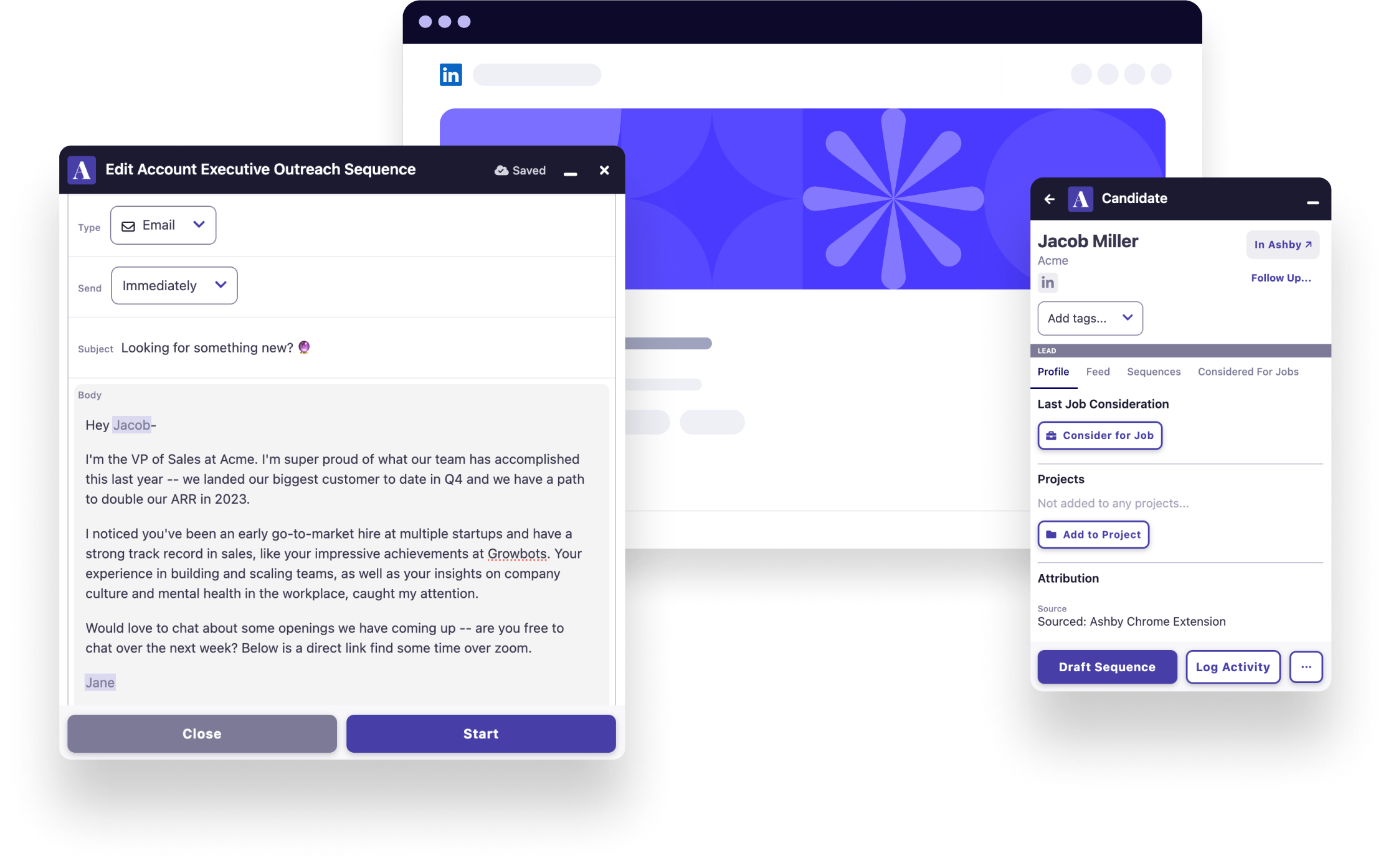
AI in Sourcing
In the first half of 2023, Ashby released AI tokens to help sourcers improve the personalization of their outreach emails while increasing productivity through intentional automation features.
In observing sourcing email sequences that did or didn’t use Generative AI tokens, there’s a considerable (~46%) lift in reply rate for campaigns using AI personalization (35.3% vs 24.1%). [Tweet This]
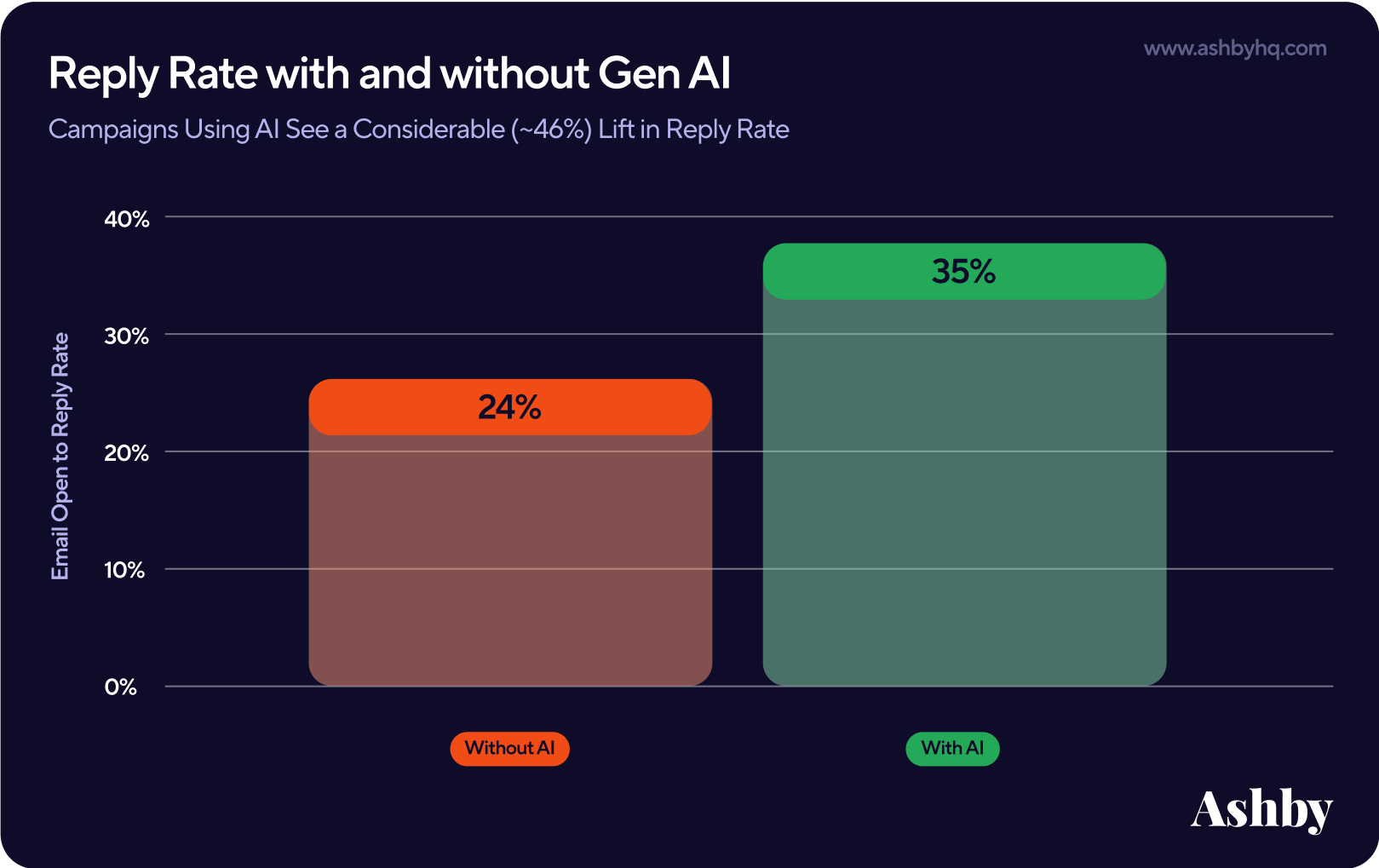
While this feature as a sourcing tool is relatively new, both Blacksmith and Liveflow immediately noticed an improvement in reply rates to their sequences when using AI generated personalization.
At Liveflow, Technical Recruiter Kiera Cox shared how personalizing email sequences with AI automations has not only enabled each member of her team to reach out to 150 people per week, but do so while experiencing higher response rates and anecdotal praise from potential candidates. This is particularly helpful for a startup with less employer brand awareness. Some candidates voiced that they responded only because of the personalized outreach.
“The one thing that we’ve gotten a ton of positive feedback from candidates is the AI outreach feature Ashby has in these sequences. I get candidates all the time — in emails and on calls — say things like ‘I’ve never gotten such a personalized recruiter outreach message before.’ It saves me so much time and is one of the biggest difference makers for us. Using Ashby’s AI helps us source more quickly while still sending out way higher quality emails.”
— Kiera Cox, Technical Recruiting at Liveflow
With thousands of sourcing campaigns under their belt, the qualitative story is similar for the talent team at Blacksmith Agency. Recruiters Juan Herrera and Autumn Gomez shared how sequences using AI result in higher response rates, which led to adoption across the team.
“Juan taught the whole team how to use the Ashby AI features. We use it as springboards a lot where it gets you 75% of the way there and you just want to tweak it a bit.”
— Autumn Gomez, Team Lead Corporate Recruiter at Blacksmith Agency
AI Tokens in Ashby
Our AI substitution tokens can be used in your email sequences and LinkedIn outreach, serving as both a research assistant and copywriter. It automatically generates text for your emails, helping you to draft compelling copy. It will take into account the job description and the candidate’s work history. Request a demo to see more than the video snippet below.
“It definitely saves me a lot of time and drives up our response rates. If I were to give that much personalization by writing from scratch, it would probably take me double the time if not triple having to read the profile and synthesize some points to call out. So the result would be either I couldn’t send as much outreach or it would take me double the time and drive me crazy.”
— Kiera Cox, Technical Recruiting at Liveflow (and Ashby AI Tokens Power User)
Conclusions
Through analyzing over 500K email sequences sent through Ashby between January 2022 and January 2024, we ultimately found:
- Email open and reply rates generally remain stable over time.
- Sourcing continues to play an essential role in recruiting, even alongside the rapidly growing volume of inbound applications.
- Personalizing emails can lead to a considerable increase in reply rates, while simultaneously saving time if using a tool like Ashby’s AI tokens.
We hope these insights help talent teams navigate, evolve, and inform their strategy around candidate sourcing. For more recruiting insights and benchmarks subscribe to our Talent Trends newsletter.
Other Reports
Talent Trends Report | Candidate Experience Surveys
Our analysis of 67.4K surveys requests sent and 11.9K survey responses received unveil valuable insights for recruiters designing Candidate Experience Surveys.
Offer Acceptance Rates | Talent Trends Report
We analyzed Offer Acceptance Rate (‘OAR’) patterns over a three year period to share valuable insights and benchmarks for talent teams.
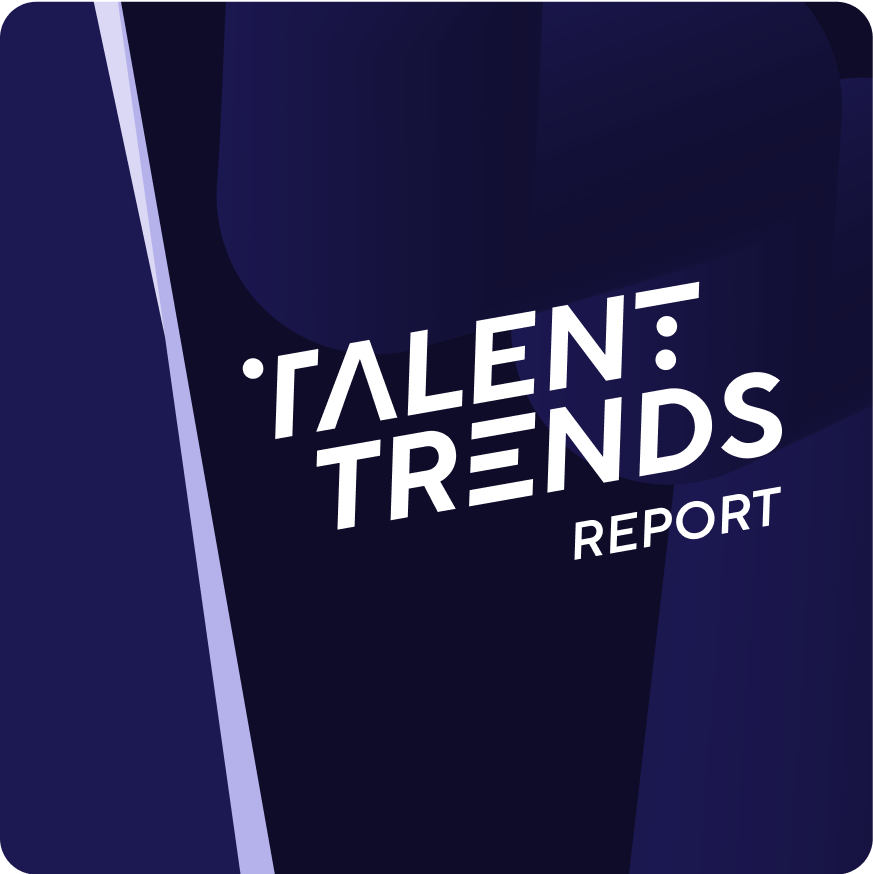
Subscribe for more talent trends and insights
We will be regularly releasing new reports around trends and insights we're seeing in our data and you will be the first to know.